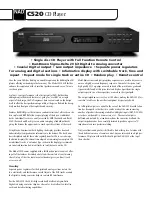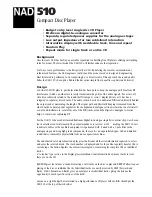
5
level on the both Level Meters.
This system has also been carefully designed so as to
minimize influence each other between azimuth and
height adjustment.
2.1.2.
Erase Head
Fig. 2.1.3 shows the sectional view of the Erase Head. Fig.
2.1.4 shows the characteristics of erasing current and
erasure.
It has the same characteristics with the previous type
Direct-Flux Erase Head but been purposely developed to
minimize the size further.
Conventional Erase Head had its inside core narrower
than its outside core, while this Erase Head is equipped
with an inside core wider than the outside core. This has
resulted more power sufficient enough for erasing with
small power consumption, approx. 0.5 W, though the head
width is as small as 3 mm. The smaller the power con
sumption is, the smaller will be the heat generation, and
this is of course another merit.
2.1.3. Double Capstan Tape Drive
As shown in Fig. 2.1.5, the double capstan system con
sists of two capstan shafts (a) and (b) connected to the
two flywheels which are driven by a capstan belt.
Against these capstans two pressure rollers (a) and (b)
are engaged to run the tape with an adequate holdback
ten sion created by the double capstan and pressure
rollers. Since the diameter of capstan shaft (a) is smaller
than that of capstan shaft (b), when two flywheels begin to
turn as shown in the figure, capstan (a) runs slightly faster
than capstan (b), which subsequently generates holdback
ten sion.
As you note, if the diameters of the 2 capstans should be
the same, the generation cycles of wow and flutter will be
come approximately the same, as a result of which defe
ctive portion will be doubly superposed and preferable
portion vice versa. The N-481 employs 2 capstans, each
having different diameter and rotations, thereby avoiding
(4)
Erase
Head Height and Tilt Adjustment
Erase Head is affixed onto the Erase Head Plate which is
assembled with the Head Base. It is installed with three
screws. By turning these screws, its height, tilt of back
ward or frontward, and tilt of leftward or rightward can be
adjusted separately, thus the best location of Erase Head
can be obtained.
the aforesaid occurrence and stabilizing wow and flutter
characteristics.
As the double capstan system always creates a constant
and stable holdback tension between the two capstans,
the condition of the tape between two capstans will not be
affected by any external conditions such as irregular
take-up and supply torques, irregular loading of cassette
tape, undesirable mechanism vibration and etc., thus
assuring the superior wow and flutter characteristics. The
double capstan system provides a constant holdback
tension on the tape and maintains the stable pressure
onto the tape against the heads.
The only critical factor in the double capstan system is to
be considered; the two capstans have to be positioned
per fectly in parallel and to be precisely vertical against
the head base, the pressure rollers have to be evenly
pressed against the capstan shafts and the head surface
must be
Summary of Contents for 481
Page 1: ......
Page 4: ......
Page 17: ......
Page 20: ......
Page 22: ......
Page 36: ...6 PARTS LOCATION FOR ELECTRICAL ADJUSTMENT ...
Page 37: ......
Page 38: ......
Page 39: ......
Page 40: ......
Page 41: ......
Page 42: ......
Page 43: ......
Page 44: ......
Page 45: ......
Page 46: ......
Page 47: ......
Page 48: ......
Page 49: ......
Page 50: ......
Page 51: ......
Page 52: ......
Page 53: ......
Page 54: ......
Page 55: ......
Page 56: ......
Page 57: ......
Page 58: ......
Page 59: ......
Page 60: ......
Page 61: ......
Page 62: ......
Page 63: ......
Page 64: ......
Page 65: ......
Page 66: ......







































